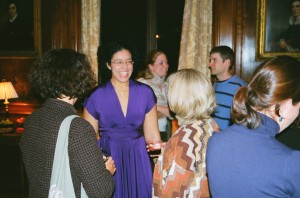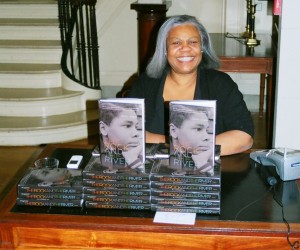I’ve attended a lot of book launch parties in my day. It’s pretty exciting when anyone you know has a new book out, but nothing tops celebrating your own debut. There’s a lot to consider, but if you take a little time to think it through, the party can go really smoothly!
Choose your venue. First, consider what kind of party are you going to have: An adults-only party with cocktails and mingling? A kid-friendly outdoor picnic? A bookstore-based event with a reading? A catered dinner at a local restaurant? Do you want a place that will provide food, or do you want to arrange your own snacks? A lot will depend on how much you want to spend and who you plan to invite, which depends on who you know. If you live in the suburbs and have a bunch of friends with young children, consider a family-friendly option. If you’re thirty and most of your friends are single and like to drink, a bar or restaurant with a private room may be a perfect gathering place. A lot of bars and restaurants allow you to reserve private rooms for free, assuming you’ll order food and drinks while you occupy the space.
Plan your refreshments. No party is complete without a little food and drink. Depending on your venue, this might be easy or difficult. If it’s a bar/restaurant, you’ll need to choose whether you’ll pick up the tab for food and drinks, or if your guests will pay as they go. You might order a few party platters from the kitchen for the group to snack on, but allow people to order and pay for their own drinks. Discuss it with the venue, and price it out. If you’re in a different kind of space, you’ll have to make separate arrangements for the food. You could hire caterers, buy snacks yourself, or ask a few close friends to bring various party trays. Are you going to serve alcohol? Always provide non-alcoholic beverages as an option, too.
Set a time frame. Unless you’re plan a catered dinner ($$$), people will likely drop in when they can, so you want to choose a large enough window that people don’t feel like they have to be there exactly on time, but small enough that you. Two to three hours should do the trick, depending on the venue and the number of people. Setting a closing time is helpful so people don’t think they can just show up hours later, but no worries if it goes over time.
Line up some party assistants. Don’t try to go it alone! Your family and close friends will be excited to help you plan and execute your party. During the event, you want to be floating, chatting, signing books and generally enjoying being the center of attention, not worrying about whether the pretzel bowl is still full. Assign a friend to manage the snacks and keep them replenished. The same friend, or another, can keep an eye on the drinks table, or even serve beverages to people. You might choose an artistic friend or two to be your designated photographers–you’ll want photos after the fact. I had a fairly large party, so I assigned my brother as a greeter to meet people at the door. He pointed out things like the coat closet, the refreshments area, my signing area, and where they could buy books. Rather than being a burden on people, it actually gave them something to do at the party, and made some of my shyer friends feel more comfortable being in a social setting with a lot of people they didn’t know.
Name your event.In my experience, people are more likely to show up to a “book launch party” than to a “book signing.” if you can come up with a cool sounding name, it’s even better. Perhaps incorporate your book title, if that works, or your own name. “Kekla’s Book Launch Extravangaza.” (I don’t know. Naming parties isn’t my strong suit. I’ll work on it…) Regardless, be excited when you talk about it. The party should match your personality (or your book’s personality) and allow you to shine. Convey the fact that there will be snacks, and people will have fun while celebrating alongside you. Depending on the circles you run in, a lot of your friends may have no idea what to expect from a book party.
Invite everyone. You’ll want to seriously consider how many contacts you have, and think really broadly. Not everyone you invite will come, of course. That’s just life. But you also might be surprised at who does come. Don’t limit your guest list based on who you think will want to attend. Easily fifteen distant acquaintances that I would never have expected to show up for my book launch actually came. Because I invited them haphazardly during a long sweep of my inbox, in a moment of excitement, wanting everyone in the world to know about my book. My best hope was that a few of them would buy it online, and stick it in a closet somewhere. They proved me very wrong–I shouldn’t have underestimated them!
Invite them repeatedly. Send a Save the Date email as soon as you know the date. Send a follow-up invite about six weeks before the event. Send a reminder about a week before. Send. Create a Facebook event. Tweet a countdown. Keep it in people’s minds. It doesn’t have to be the same exact message every time. Perhaps drop little tidbits about the book, or send around any good review quotes that come in. This is how you generate buzz.
Ask for RSVPs. Let people know that it’s important to get an accurate head count so you can order an appropriate amount of books. And food. Don’t press the issue, or give a deadline for RSVP, though. You don’t want people to fear they shouldn’t show up at the last minute.
Inform the local press. I highly recommend this, especially if you live in a small to medium community, or have lived in your community for a long time. It felt silly to me to notify the New York Times of my signing in Manhattan (I didn’t), but I did send press releases to the Journal Gazette and News Sentinel in Fort Wayne, Indiana, when I planned a local event in my hometown. They published the announcement! Friends from high school who I’d forgotten about saw it and came. As did a lot of my parents’ friends, and a few random strangers. A local community paper also printed an interview with me along the theme of “hometown girl, grown up,” which landed me a paid visit to my local library.
Have copies of your books on sale. This is an absolute must. Do not be shy. The people who come out to celebrate your book launch want to support you, and supporting an author means buying their book. People need to understand that. (You’d be surprised how many acquaintances of mine thought I would be giving books away to everyone I knew. Don’t give away free copies.) Most local independent bookstores will order books for you and send a representative to your event to sell them for you. This eliminates a huge headache for you, not to mention a big expense of buying copies to resell. But, if you prefer, you can order the books yourself and assign a friend sell them for you. Not everyone will buy the book on the spot, but a lot of them will. Some might even buy gift copies. You may want to set aside a time for signing, or you can just do
it on the fly as people ask. (Important note: A bookstore rep will usually be able to take credit card sales. If you sell books yourself, let people know by email in advance if the books will be available for cash only. Most people pay with twenties, so you’ll need plenty of bills to make change. Have receipts available. Some people might ask for one.)
Decide if you will speak. This can feel awkward, especially if it’s your first time in front of a crowd to talk about your book. But I think it’s an important opportunity. Honestly, I didn’t do it at my first party, and I wish I had. When you feel like most people have arrived, you can just take a moment to thank folks for coming, speak a little bit about the book. (5-10 minutes, tops. No grandstanding.) Invite people to buy it if they haven’t already, and remind them you’ll be signing copies. One easy way to get yourself “onstage” is to ask a friend or family member to initiate things by offering a toast to your new book. He can get people’s attention and say something brief but nice about you, then turn the “mike” over to you for your brief remarks. You probably know someone who’d be perfect in this capacity.
Go to other people’s parties. It’s always fun. You’ll look around and see how they organized their party, and you’ll pick up tips for your own. Besides, supporting your fellow writers is a great way to build a following for yourself. Show up for people, and it will mean something to them. They will remember. So, even when it’s cold out and you’d rather stay in your jammies and you don’t even know the person that well anyway, GO. On the way there, reflect on how badly you’ll want them show up for you!
I found some posts with more book party-planning tips:
Editorial Ass has a great piece on planning a book launch: http://editorialass.blogspot.com/2010/05/how-to-throw-awesome-book-launch.html
The Writer’s Handbook gives a rundown on WHY to have one: http://writershandbook.wordpress.com/2009/03/19/plan-a-great-book-launch-party/
A Lee and Low author talks about her personal experience planning a book launch for her book: http://blog.leeandlow.com/2009/11/11/how-to-plan-a-successful-book-launch/




 o be shy about handing people my contact information. I’ve come to realize that people who end up in conversation with me about my writing are genuinely interested in it. The others will blow me off or change the subject without a second’s hesitation.
o be shy about handing people my contact information. I’ve come to realize that people who end up in conversation with me about my writing are genuinely interested in it. The others will blow me off or change the subject without a second’s hesitation.
 The Women’s Mosaic is a New York City-based non-profit organization that provides education, inspiration, and motivation for women to rise up and rock the world! The Women’s Mosaic unites and empowers women through programs that promote intercultural understanding and personal growth. We are a community of diverse, dynamic women interested in expanding our horizons by creating positive change that can individually and collectively enrich the world.
The Women’s Mosaic is a New York City-based non-profit organization that provides education, inspiration, and motivation for women to rise up and rock the world! The Women’s Mosaic unites and empowers women through programs that promote intercultural understanding and personal growth. We are a community of diverse, dynamic women interested in expanding our horizons by creating positive change that can individually and collectively enrich the world.